Updated: 22-Mar-2018
The Dufaux brothers made a double-acting, four-stroke, five-cylinder inline engine, was equivalent to a 20-cylinder engine.
-20-cylinder engine whose information is filed at the Nasm with reference Doc. (BD-926000-01).
From Appendix 6: Brothers Armand and Henri Dufaux are considered pioneers of aviation in Switzerland and, as we will see, in the world.
-One of their first projects was a helicopter with a 3 CV internal combustion engine.
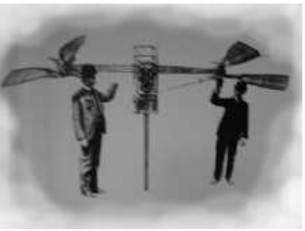
"The Dufaux brothers and their helicopter"
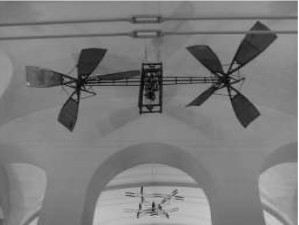
"Dufaux helicopter reproduction in Paris"
-At the Museum of Arts and Matters in Paris there is a replica of the Dufaux brothers' helicopter hanging from the roof next to other devices.
-This helicopter used a small and original gasoline engine. It had a double cylinder with two pistons in tandem and offered both sides of these to produce power, so actually it was a four-cylinder engine in one physical one.
-It was inside a wooden structure with two booms where some shafts drove the four rotors of two meters in diameter that rotated in opposite directions.

“The Dufaux testing”
-The helicopter weighed 17.450 Kgs and the engine 4.500 Kgs. It was air cooled, and as we will see later, it served as the basis for a bigger one.
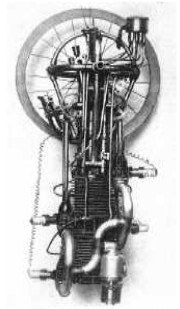
"3 CV Dufaux engine, really 3'1 CV"
-But as it is mentioned in the main text, their 20-cylinder engine is something extraordinary for its architecture. It is exposed at the Transport Museum in Lucerne (Luzern).

"Dufaux 20 cylinder engine"
-It is difficult to deduce the 20 cylinders at first glance, they are in vertical position and inverted.
-They are placed in a row of five double cylinders with double-active pistons, resulting in four combustion chambers in each double cylinder.
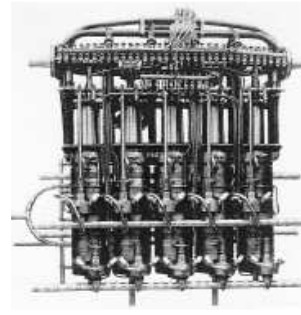
“Side details” (Foto by Schweizer Luftfahrt)
-In this photograph we observe the two spark plugs of the upper piston sides, one spark plug for each active upper side and also their exhaust ducts.
-In the picture below we see the spark plugs of the lower active piston sides and also their exhaust ducts.
-All the water sleeves that wrap the cylinders are of red copper.

"Dufaux schematic diagram"

“Amplified details” (Foto JGB)

"Lubrication distributors" (Photo JGB)
From Appendix 7: A new photo of the engine of their 1903 helicopter. With a double acting piston and two tandem cylinders.
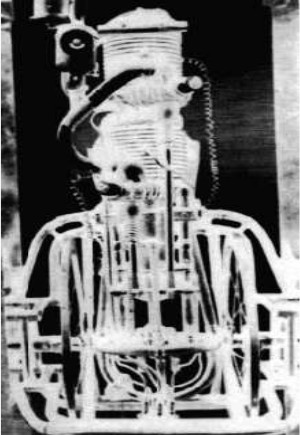
“The Dufaux brothers' 3.1 CV engine” (PiP)
-Switzerland. Below we publish a new photograph that was taken at the 1912 Olympia exhibition, showing a single-cylinder engine but with double effect pistons.
-In the main text it appears in negative for not being able to identify the possible credit.
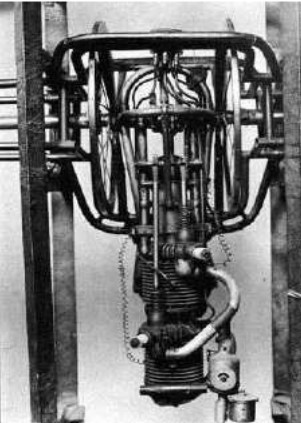
"Effective view of a 1912 Dufaux engine"

"Full photo of the two Dufaux brothers"
-This photo appears in the main text with a blurred background. The engine looks the same as before.
Engines of DUFAUX
Model: 20 cyl.
Arquitecture: 4-stroke20-cylinder
Cooling: Air
Total Displacement:
Bore / Stroke:
Power:
Weight:
Five-double-cylinder inline engine, with double-acting pistons. With its four-stroke cycle it was equivalent to a 20-cylinder engine. Each double cylinder had four combustion chambers.

"20-cylinder Dufaux engine"
Model: 4 cyl., 3 CV (Helic.)
Arquitecture: 4-cylinder
Cooling:
Total Displacement:
Bore / Stroke:
Power: 3 CV
Weight:
Double-cylinder in-tandem engine, with double-acting pistons. With its four-stroke cycle it was equivalent to a 4-cylinder engine. The double cylinder had four combustion chambers.

"Dufaux engine from 1912"


